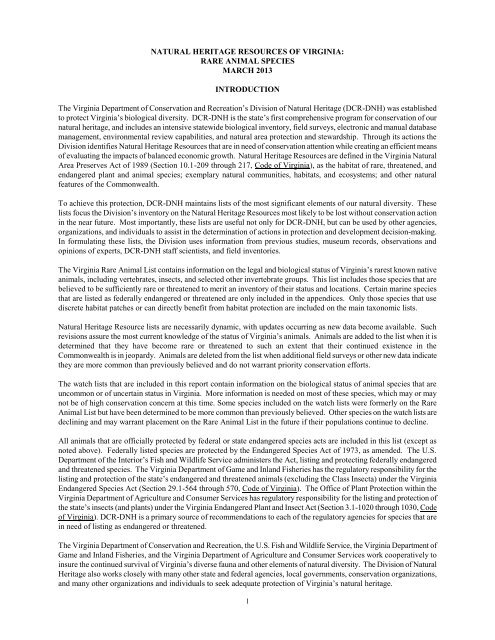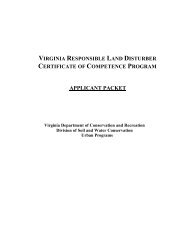Rare Animals - Virginia Department of Conservation and Recreation ...
Rare Animals - Virginia Department of Conservation and Recreation ...
Rare Animals - Virginia Department of Conservation and Recreation ...
You also want an ePaper? Increase the reach of your titles
YUMPU automatically turns print PDFs into web optimized ePapers that Google loves.
NATURAL HERITAGE RESOURCES OF VIRGINIA:<br />
RARE ANIMAL SPECIES<br />
MARCH 2013<br />
INTRODUCTION<br />
The <strong>Virginia</strong> <strong>Department</strong> <strong>of</strong> <strong>Conservation</strong> <strong>and</strong> <strong>Recreation</strong>’s Division <strong>of</strong> Natural Heritage (DCR-DNH) was established<br />
to protect <strong>Virginia</strong>’s biological diversity. DCR-DNH is the state’s first comprehensive program for conservation <strong>of</strong> our<br />
natural heritage, <strong>and</strong> includes an intensive statewide biological inventory, field surveys, electronic <strong>and</strong> manual database<br />
management, environmental review capabilities, <strong>and</strong> natural area protection <strong>and</strong> stewardship. Through its actions the<br />
Division identifies Natural Heritage Resources that are in need <strong>of</strong> conservation attention while creating an efficient means<br />
<strong>of</strong> evaluating the impacts <strong>of</strong> balanced economic growth. Natural Heritage Resources are defined in the <strong>Virginia</strong> Natural<br />
Area Preserves Act <strong>of</strong> 1989 (Section 10.1-209 through 217, Code <strong>of</strong> <strong>Virginia</strong>), as the habitat <strong>of</strong> rare, threatened, <strong>and</strong><br />
endangered plant <strong>and</strong> animal species; exemplary natural communities, habitats, <strong>and</strong> ecosystems; <strong>and</strong> other natural<br />
features <strong>of</strong> the Commonwealth.<br />
To achieve this protection, DCR-DNH maintains lists <strong>of</strong> the most significant elements <strong>of</strong> our natural diversity. These<br />
lists focus the Division’s inventory on the Natural Heritage Resources most likely to be lost without conservation action<br />
in the near future. Most importantly, these lists are useful not only for DCR-DNH, but can be used by other agencies,<br />
organizations, <strong>and</strong> individuals to assist in the determination <strong>of</strong> actions in protection <strong>and</strong> development decision-making.<br />
In formulating these lists, the Division uses information from previous studies, museum records, observations <strong>and</strong><br />
opinions <strong>of</strong> experts, DCR-DNH staff scientists, <strong>and</strong> field inventories.<br />
The <strong>Virginia</strong> <strong>Rare</strong> Animal List contains information on the legal <strong>and</strong> biological status <strong>of</strong> <strong>Virginia</strong>’s rarest known native<br />
animals, including vertebrates, insects, <strong>and</strong> selected other invertebrate groups. This list includes those species that are<br />
believed to be sufficiently rare or threatened to merit an inventory <strong>of</strong> their status <strong>and</strong> locations. Certain marine species<br />
that are listed as federally endangered or threatened are only included in the appendices. Only those species that use<br />
discrete habitat patches or can directly benefit from habitat protection are included on the main taxonomic lists.<br />
Natural Heritage Resource lists are necessarily dynamic, with updates occurring as new data become available. Such<br />
revisions assure the most current knowledge <strong>of</strong> the status <strong>of</strong> <strong>Virginia</strong>’s animals. <strong>Animals</strong> are added to the list when it is<br />
determined that they have become rare or threatened to such an extent that their continued existence in the<br />
Commonwealth is in jeopardy. <strong>Animals</strong> are deleted from the list when additional field surveys or other new data indicate<br />
they are more common than previously believed <strong>and</strong> do not warrant priority conservation efforts.<br />
The watch lists that are included in this report contain information on the biological status <strong>of</strong> animal species that are<br />
uncommon or <strong>of</strong> uncertain status in <strong>Virginia</strong>. More information is needed on most <strong>of</strong> these species, which may or may<br />
not be <strong>of</strong> high conservation concern at this time. Some species included on the watch lists were formerly on the <strong>Rare</strong><br />
Animal List but have been determined to be more common than previously believed. Other species on the watch lists are<br />
declining <strong>and</strong> may warrant placement on the <strong>Rare</strong> Animal List in the future if their populations continue to decline.<br />
All animals that are <strong>of</strong>ficially protected by federal or state endangered species acts are included in this list (except as<br />
noted above). Federally listed species are protected by the Endangered Species Act <strong>of</strong> 1973, as amended. The U.S.<br />
<strong>Department</strong> <strong>of</strong> the Interior’s Fish <strong>and</strong> Wildlife Service administers the Act, listing <strong>and</strong> protecting federally endangered<br />
<strong>and</strong> threatened species. The <strong>Virginia</strong> <strong>Department</strong> <strong>of</strong> Game <strong>and</strong> Inl<strong>and</strong> Fisheries has the regulatory responsibility for the<br />
listing <strong>and</strong> protection <strong>of</strong> the state’s endangered <strong>and</strong> threatened animals (excluding the Class Insecta) under the <strong>Virginia</strong><br />
Endangered Species Act (Section 29.1-564 through 570, Code <strong>of</strong> <strong>Virginia</strong>). The Office <strong>of</strong> Plant Protection within the<br />
<strong>Virginia</strong> <strong>Department</strong> <strong>of</strong> Agriculture <strong>and</strong> Consumer Services has regulatory responsibility for the listing <strong>and</strong> protection <strong>of</strong><br />
the state’s insects (<strong>and</strong> plants) under the <strong>Virginia</strong> Endangered Plant <strong>and</strong> Insect Act (Section 3.1-1020 through 1030, Code<br />
<strong>of</strong> <strong>Virginia</strong>). DCR-DNH is a primary source <strong>of</strong> recommendations to each <strong>of</strong> the regulatory agencies for species that are<br />
in need <strong>of</strong> listing as endangered or threatened.<br />
The <strong>Virginia</strong> <strong>Department</strong> <strong>of</strong> <strong>Conservation</strong> <strong>and</strong> <strong>Recreation</strong>, the U.S. Fish <strong>and</strong> Wildlife Service, the <strong>Virginia</strong> <strong>Department</strong> <strong>of</strong><br />
Game <strong>and</strong> Inl<strong>and</strong> Fisheries, <strong>and</strong> the <strong>Virginia</strong> <strong>Department</strong> <strong>of</strong> Agriculture <strong>and</strong> Consumer Services work cooperatively to<br />
insure the continued survival <strong>of</strong> <strong>Virginia</strong>’s diverse fauna <strong>and</strong> other elements <strong>of</strong> natural diversity. The Division <strong>of</strong> Natural<br />
Heritage also works closely with many other state <strong>and</strong> federal agencies, local governments, conservation organizations,<br />
<strong>and</strong> many other organizations <strong>and</strong> individuals to seek adequate protection <strong>of</strong> <strong>Virginia</strong>’s natural heritage.<br />
1
















